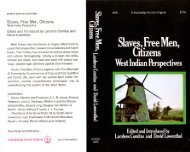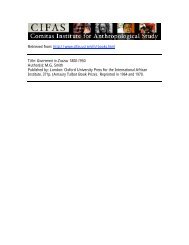Create successful ePaper yourself
Turn your PDF publications into a flip-book with our unique Google optimized e-Paper software.
<strong>Kano</strong> <strong>Chronicle</strong> 41<br />
v<br />
In a blilliant recent discussion of the <strong>Chronicle</strong>, ~l'1urray Last obliquely<br />
suggests that it is best regarded as a rather free compilation of local legends<br />
and traditions drafted in the miJ-scventeenth century by a humorous<br />
Muslim rationalist who almost seems to have studied under Levi-Strauss. 6 6<br />
There arc a number of cross-cutting binary sets in the "analogical geographies"<br />
the <strong>Chronicle</strong> apparently reveals, but more triangles with oppositions<br />
and mediators a la Levi-Strauss. Yet surely even if structuralism describes<br />
the universally valid pattern of human thought, this would not<br />
dispense ,'\lith the ordinary Cliteria and aims of historicity. Though Last<br />
does not conclude that the <strong>Chronicle</strong> is poor history, many might readily<br />
assume that this is implied, from the style and organization of his discourse.<br />
His paper itself does not support such a view, however, despite its analysis<br />
of the differing traditions recorded in the first ten reigns of the <strong>Chronicle</strong>,<br />
during which the immigrants led by Bagauda struggled to dominate and<br />
destroy the native community of <strong>Kano</strong>. All this is of the greatest value.<br />
Together those reigns cover the period from 389 A.H. or 999 A.D. to 743<br />
A.H. and] 343 A.D. - that is, the legendary first three and a half centuries<br />
of <strong>Kano</strong>'s history, following the arrival of Bagauda and his 'host'. While the<br />
events and symbols recorded in the <strong>Chronicle</strong> to express the opposition of<br />
immigrants and natives are· all probably in some sense 'untrue', the nature·<br />
and intensity of that opposition cannot be gainsaid a priori or on available<br />
records. The immigrants were determined to conquer and rule the acephalous<br />
peoples of Kana, just as the latter, called Abagiyawa, were determined<br />
to resist as best they could. It might of course be argued that there<br />
was no such invasion of <strong>Kano</strong> by 'Bagauda' or others at this period; but there,<br />
is sufficient evidence of cum~lative population movements within and<br />
around this region between the 7th and 11th centuries A.D. to suggest that<br />
such a flat, fertile and attractive country as Kana would be very likely to<br />
receive sub~tantial immigration from the north and east.<br />
Concluding that the original draft of the <strong>Chronicle</strong> was made not long<br />
after 1650 A.D., Murray Last distinguishes three preceding periods in its<br />
account of <strong>Kano</strong> history that differ significantly in the sources, status and<br />
reliability or the data on which they are based. For the period before 1450<br />
A.D. he has little confidence in the Chroniclc's historicity; and he questions<br />
its accuracy for the following century, 1450-1550 A.D. From 1550 onwards,<br />
despite reservations, he has increasing confidence in the document's validity;<br />
and from 1650 A.D. he is satisfied. 6 7<br />
Last supports this evaluation of the <strong>Chronicle</strong> by comparing the numbers<br />
of rulers and lengths of reigns it records 'with similar data from the Song<br />
of Bagauda and Dr. Baikje's king list for the periods before 1430 (i.e. before<br />
Dawuda), between 1430 and Soyaki's accession in 1652, and since then.





